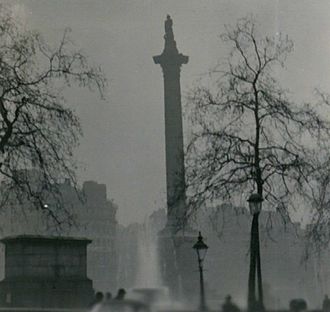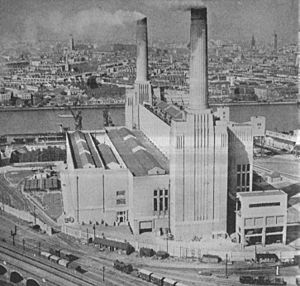Great Smog of London facts for kids

Nelson's Column during the Great Smog
|
|
| Date | 5–9 December 1952 |
|---|---|
| Location | London, England |
| Casualties | |
|
|
The Great Smog of London, also known as the Great Smog of 1952, was a very serious air pollution event. It covered London, the capital city of Britain, in early December 1952. During this time, the weather was unusually cold. There was also an anticyclone, which means the air was still and there was no wind. This trapped a thick layer of smog over the city. The smog was made mostly of pollution from burning coal.
The Great Smog lasted from Friday, December 5th, to Tuesday, December 9th, 1952. It disappeared quickly once the weather changed. This smog was much worse than earlier smog events, which people called "pea-soupers". It made it very hard to see and even got inside buildings.
Government reports soon after the event said that about 4,000 people had died directly because of the smog by December 8th. Also, 100,000 more people became ill from the smog's effects on their lungs and breathing system. More recent studies suggest that the total number of deaths might have been much higher, possibly between 10,000 and 12,000 people.
London had problems with bad air quality since the 13th century, and it got worse in the 1600s. The Great Smog is thought to be the worst air pollution event in the history of the United Kingdom. It was also very important because it led to new research about the environment. It made the government create new rules and made people more aware of how air quality affects health. Because of the smog, several changes were made, including the Clean Air Act 1956.
Contents
Why the Great Smog Happened

Before and during the Great Smog, the weather was very cold. This made people in London burn much more coal than usual to stay warm. After World War II, the better quality "hard" coals were often sent to other countries to help pay off war debts. So, people at home often burned a lower quality, more sulphurous coal. This type of coal released more sulphur dioxide into the smoke.
There were also many power stations in the Greater London area that burned coal. These included Fulham, Battersea, Bankside, Greenwich, and Kingston upon Thames. All of these added to the pollution.
The UK's Met Office (weather service) estimated how much pollution was released each day during the smog:
- 1,000 tonnes of smoke particles
- 140 tonnes of hydrochloric acid
- 14 tonnes of fluorine compounds
- 370 tonnes of sulphur dioxide (which could turn into 800 tonnes of sulphuric acid)
The large water droplets in London's fog helped create sulphates. The resulting weak acid became stronger when the sun later cleared the fog.
Some research suggests that pollution-prevention systems at places like Battersea Power Station might have actually made the air worse. These systems cooled the gases coming out of the chimneys. This meant the gases didn't rise high into the air but instead sank to ground level, causing more pollution nearby.
Other sources also added to the air pollution. These included exhaust from vehicles, especially steam trains and diesel buses. Diesel buses had recently replaced the electric tram system. Other factories and businesses also contributed to the bad air.
How the Weather Caused the Smog
On December 4, 1952, an anticyclone settled over London. This meant there was no wind. It also caused a temperature inversion. This is when a layer of warm air traps cold, still air underneath it, like a lid.
The fog then mixed with smoke from homes and factories. It also mixed with tiny particles from car exhausts and other pollutants like sulphur dioxide. This created a thick, lasting smog that covered London the next day. The black, sticky soot particles gave the smog its yellow-black color. This is why it was nicknamed "pea-souper". Because there was no wind, the pollution could not spread out. This allowed a huge amount of pollutants to build up.
Impact of the Great Smog
How London Was Affected
Londoners were used to heavy fogs, but this one was much thicker and lasted longer than any before. It was so hard to see that visibility was only a few meters. People said it was "like you were blind." This made driving very difficult or impossible.
Most public transport stopped, except for the London Underground (subway). The ambulance service also stopped, so people had to find their own way to the hospital. The smog was so thick that it even seeped indoors. Concerts and movie showings were cancelled or stopped because people couldn't see the stage or screen from their seats. Outdoor sports events were also called off.
In the quieter streets away from the city center, there was no moving traffic to help thin out the fog. This meant visibility could be as low as one meter during the day. Walking outside meant shuffling your feet to feel for things like curbs. At night, it was even worse. The street lamps at the time used incandescent light bulbs, which didn't shine light onto the pavement for pedestrians to see their feet or even the lamp post. Special fog-penetrating fluorescent lamps didn't become common until later in the 1950s. Some people bought "smog masks" from chemists to try and protect themselves.
Health Effects of the Smog
At first, people didn't panic because London was known for its fogs. However, in the weeks that followed, doctors and medical services collected information. They found that the fog had caused 4,000 deaths. Most of the people who died were very young, elderly, or already had breathing problems. In February 1953, a politician named Marcus Lipton told the House of Commons (part of the British Parliament) that the fog had caused 6,000 deaths. He also said that 25,000 more people in London claimed sickness benefits (money for being sick) during that time.
Even months after the fog cleared, more people continued to die than usual. An early report, which was never finished, blamed these deaths on a flu epidemic. However, new evidence showed that only a small number of deaths were from the flu. Most deaths were caused by serious respiratory tract infections. People died from lack of oxygen and from their airways being blocked by pus from lung infections caused by the smog. The lung infections were mainly bronchopneumonia or severe bronchitis (inflammation of the airways), often on top of existing long-term bronchitis.
Research published in 2004 suggests that the total number of deaths was much higher than first thought, possibly around 12,000.
Environmental Changes After the Smog
The Great Smog led to new environmental laws in the UK. These included the City of London (Various Powers) Act 1954 and the Clean Air Acts of 1956 and 1968. These laws helped reduce air pollution.
People were given money to encourage them to replace their open coal fires with other heating methods, like gas fires. If they preferred to burn solid fuel, they were encouraged to use coke, which produces very little smoke. At that time, central heating (using gas, electricity, oil, or approved solid fuel) was not common in most homes. It didn't become popular until the late 1960s. Even with these improvements, there was still another smog event about ten years later, in early December 1962.
The Great Smog in Stories
The Great Smog is a main event in season 1, episode 4 of the Netflix show The Crown. Critics said that the show's portrayal of the air pollution was quite accurate. However, they felt that the show greatly exaggerated the political importance and the chaos in the hospitals.
The Great Smog is also the setting for an audio play called "The Creeping Death" from the Doctor Who series.
See also
 In Spanish: Gran Niebla de Londres para niños
In Spanish: Gran Niebla de Londres para niños

